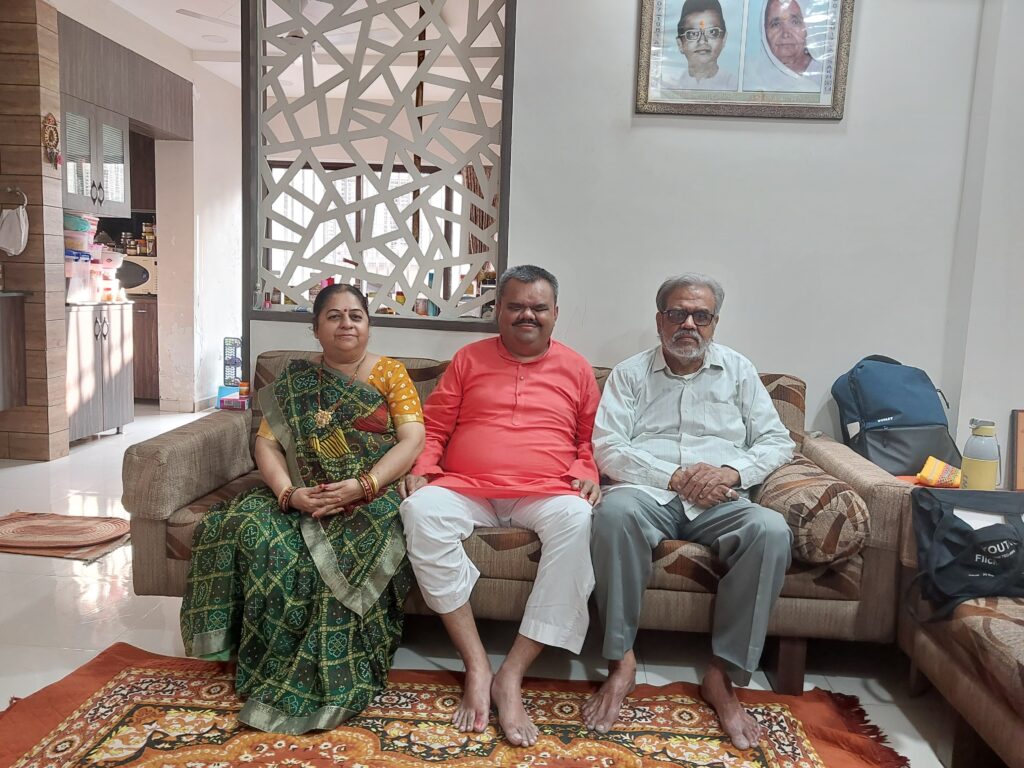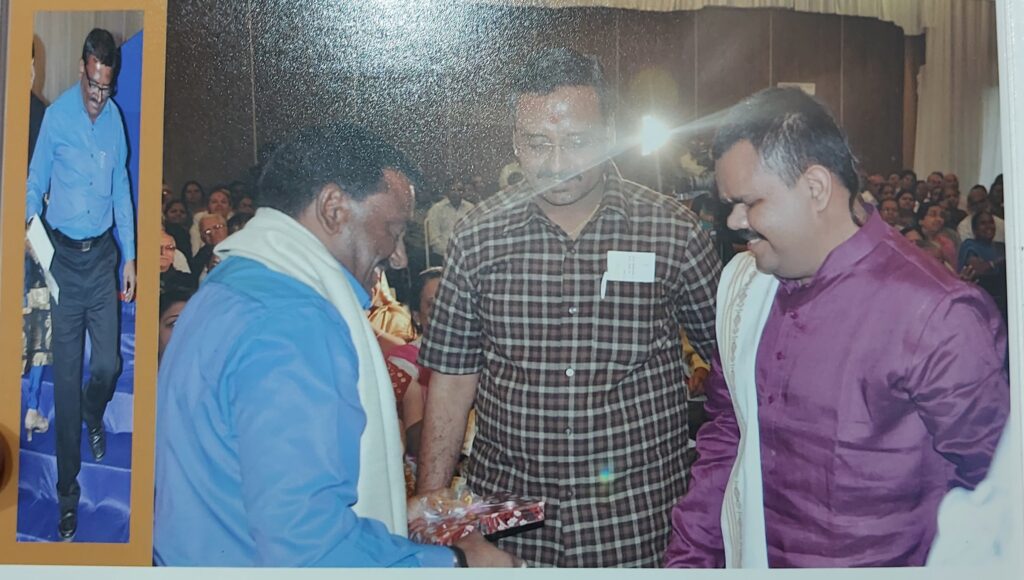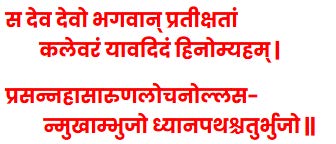What is the nature of True Sight?
What is the nature of True Sight? This was the question lingering in my head on my way home after interviewing Dr. Krunal Shastri. This brief time spent with him left me with an altered state of mind – a quiet sense that the world measures blindness by what is absent, but perhaps there is another way to measure vision — by what is present.
The Bhagavad Gita speaks of the journey from illusion to truth — a gradual unveiling of what lies beyond the curtain of maya. Most of us, despite being blessed with physical sight, live under this veil — seeing only the surface of life, distracted by what is fleeting. Yet there are rare souls who, though denied the gift of sight, can see far beyond this curtain into the essence beneath.
Krunalji is one such seer
Born in Nanihal, Maharashtra on October 14, 1987, his mother was told that her child had visual impairment after 10 days of giving birth. Both his parents tried multiple times to get him treated, visiting facilities in far away cities like Indore and Amritsar, to no avail.

“My parents then became my two eyes,” he said, smiling, “… made me capable to do this.” He describes his parents as an unshakeable support, his “friend, philosopher and guide”. With reverence, he shares how he owes everything to them as his mother watches on, from the couch, with nothing but pride in her eyes for her son. “My parents sacrificed so much for me that they never went to the theatre to watch a movie.”

Seeing his aptitude and interest in these stories, his parents encouraged him to study and learn more. He was part of the “Sankalik Shikshan Yojana” (now called “Sammilik Shikshan Yojana”) that helped people born with visual impairment learn the skills required to navigate everyday life. His teacher, a Muslim gentleman, guided him through the intricacies of mobility, walking, and Braille reading and writing — skills that became the foundation of his independence. At a time when faith could often divide, the bond they shared stood as a quiet testament to the power of human kindness beyond boundaries. Years later, when Krunalji hosted one of his most significant katha events, he invited this teacher — alongside his other gurus — to honour their role in shaping his journey and express his enduring gratitude.

In fact, there are countless unseen hands that have helped him along the way. To express his gratitude, Krunalji remembers little Krishna’s story of lifting the Govardhan mountain. When Lord Krishna lifted the Govardhan Mountain on his pinky to protect his village from the wrath of Indra, all his Gwal friends were also there with him, supporting the mountain with their lathis. “When I lift the Govardhan of my life, so many people supported me… I try to remember all of them and am grateful.” A beautiful acknowledgement that no life is ever lifted alone.
In 1988, his family moved to Ahmedabad and young Krunalji joined a specialised school in Ashram road, Navrangpura. To make ends meet, his mother worked in a candle shop while his father worked at a gas station. Income was Rs 700 while rent was Rs 500. The family of three lived with Rs 200 every month. Then in 2001, came the infamous Bhuj earthquake, India’s second deadliest earthquake. It left several cities in Gujarat, including Ahmedabad, reeling. It had caused close to 14,000 deaths and extensive property damage.
Even in such dire moments however, he felt the presence of God and thus never questioned “Why me?” He advises that one should never blame God for one’s suffering and to have a faith so deep, it does not demand explanations. He says God has his ways of being gentle and harsh when we need it. “There is grace (Krupa) in both… but while we see the grace in His gentleness, we fail to understand the grace in His harshness. To be ready, one has to do penance (tapasya). If you are not strong, you will break.”
With this unwavering surrender to God, 12 year old Krunal asked his parents to quit their jobs. In the wake of such a catastrophe from the earthquake, he decided to take the mantle of bread-winner for his family. “God created a situation for me, now I had to move forward on His path.”
Thus began his journey as a kathakar. He gave his very first Ramakatha in Ramji Mandir at Ranip Vistar, Ahmedabad. There was an audience of 60-70 people. With blessings from his parents and the priests at Ramji Mandir, he successfully completed his talk. Eager to improve his craft and expand his knowledge to other texts like Gitaji and Shrimad Bhagavad, he sought admission in Sola Bhagvat Vidyapith. In 2005, 18 year old Krunal went to attend a katha on Murari Bapu. The then principal of Vidyapith, Dr. Narendra Bhai Pandya, was also in attendance. He recognised the potential Krunalji held and recommended his father to enroll him in Vidyapith. So he completed his 12th and went on to pursue his BA and double MA in purana and dharmashastra.

Being the only student in class with visual impairment came with challenges. His professors (gurujis) were unsure of how to suit his needs since regular teaching methods did not cater to him. They lacked the proper training, awareness and the resources to help people with physical impairments. This leaves our society with a message – physical impairments never make people feel incomplete, but ignorance would have. Compassion, support and awareness are key. We can all strive to make today’s society more inclusive and safe by educating ourselves.

Krunalji took the initiative – he would record the lectures on his Walkman, and listen to it repeatedly till he had absorbed all the content. The next day, he would summarise the lesson to his professors and discuss any points of doubts. Looking at his recall power and in-depth understanding of the scriptures, the gurus developed a strong faith in him. “I have faith that Krunal will complete his PhD one day,” said the principal.
From his studies and to this day, Krunalji follows a strict daily routine. He wakes up at 4am each day, to study and complete the day’s most important work during Brahmakal, the time period from 4am to 6am. In fact, he recommended the same to me and other students,
emphasising that the spiritual path is not only for sages, but for anyone who wishes to align their lives with divine rhythm. It’s been scientifically proven that studying during this time enhances concentration and memory retention, making it ideal for peak cognitive performance. It is said studying during amrit bela makes your mind pure – like water at sunrise.
Graduating as the gold medalist at his university, Krunalji went on to pursue his PhD in Shrimad Bhagavad, specifically Bhagavatam Tenth Cantos. His PhD focus was on the five songs – Venu Gitam, Gopi Gitam, Yugala Gitam, Brahmara Gitam, and Maheshi Gitam. These are songs popular in Vraj Bhakti, sung by the Vraj Gopis to Lord Krishna. They are deeply emotional and reveal the transcendental sentiments of Mahabhava – pure and selfless, divine love for Sri Krishna.
Since successfully completing his PhD in 2017, he has narrated more than 400 kathas at various events. One he recalls fondly is from last year on January 27th at a blind school where he collected over 17 lakh rupees for charity – used for donating smart vision glasses and Orbit readers to those in need. Similarly, there was another recent event in Haridwar at his gurujis’ place – Shivagiri Guru Maharaj and Swami Rajeshwaranand Bhartiji Maharaj. The katha amassed over 11 lakh rupees to donate to Gujarati soldiers of the Indian Army who had sacrificed themselves in the line of duty. 1 lakh was given to each family of the 11 martyrs. Krunalji really believed in the art of giving back to society and thought of these acts as his duty and way of being grateful.
On December 3rd, 2016, Krunalji won the national award for Shreshtha Divyang Vyakti, presented by the Former President Dr. Pranab Mukherjee. In 2017, he was awarded Yuva Gaurav Puraskar by the Gujarat state government. Since then, he has written 4 books in Gujarati, to spread the message and essence of these religious texts to interested people who are often intimidated by their complexity. Through the help of his Orbit device, he’s written Shiv Mahima, Bhagavad Ek Drishti, Devi Vatsalya Sudha, and Mahabharat Ras Darshan. He was kind enough to gift me a copy of Shiv Mahima in Hindi as well.
He interprets the teachings of Shrimad Bhagavad in his daily life in a way that leaves him akin to the Smiling Buddha. “According to the Bhagavad Gita, I am not blind,” he says, talking about his inner eye powered by spirituality. In general, people possess two types of vision – deergha drishti (far-sightedness in worldly matters) and divya drishti (spiritual sight). He laments how the world mistakenly values the former while neglecting the latter. Possessing divya drishti, he hopes to continue narrating kathas to reach more people and spread the message.

If one spends a few minutes talking to Krunalji, it becomes obvious he loves being a kathakar. When asked about his future plans, he simply says he wants to keep telling stories with a smile on his face. “वेदानां सामवेदोऽस्मि स्मि स्मि ”, literally meaning “Of the Vedas, I am the Sama Veda.” Quoting Gita’s Chapter 10, Verse 22, he asks why Sri Krishna mentioned Sama Veda when there are other vedas that are arguably more important. It is because Sama Veda is about music and joy, beautifully written into complicated melodies and tunes. It represents happiness (Anand) and if we carry this happiness into our lives and our work, we will definitely be able to reach our goal. This is what he practices with his craft, bringing enjoyment and excitement to get better.
Around this time in the interview, I was mostly in awe, filled with admiration and spiritual contentment. When asked what advice he would give to the youth of today, he urged us to try and mould ourselves in the image of Maryada Purushottam Ram himself, while still having the whimsicality of beloved Krishna.
“नदी से जो टकराते हैं, वो तूफान कहते हैं
लेकिन तूफान से जो टकराते हैं, वो युवान कहते हैं”
It is said that in the great battlefield of Kurukshetra, Krishna stood not as a warrior, but as a charioteer — his hands quietly guiding the reins while the storm of battle raged on. Many would have seen him as a mere companion, a silent presence beside Arjuna. But those who saw with the heart would know — the true battle was not fought with arrows, but with the mind. And the true victory was not on the battlefield, but within.
Sitting with Krunal Shastriji, I could not help but feel that same silent presence. There was no spectacle in his words, no dramatic appeal to sympathy — only a steady, unshaking faith.In that moment, the two shlokas he holds closest to his heart come to life.
The first, Shrimad Bhagavatam 1.9.24:

This is when Bheeshma Pitamah, lying on his deathbed of arrows, asks God – “As long as my life doesn’t leave my body, I beseech you to stay within my sight.” With life itself being our personal Kurukshetra, the only battle is with ourselves as our mind plays the role of both Pandavas and Kauravas. Hence, we request Parthasarathi Krishna to become the charioteer of our lives.
The second, from Bhagavad Gita, Chapter 9, Verse 22:

This shloka was close to his heart for the silent reassurance Krishna provides during our hardest times. He asks us to forgo all our worries and hardships to him and have faith that He will carry us through. Krunalji finds these two shlokas to be his life philosophy and that in practising them, he finds Bhagwan to be ever close to him.
As I left the interview, the lines of the Bhagavad Gita echoed softly in my mind:

(Among thousands of men, perhaps one strives for perfection.)
Not all of us will find that perfection. But meeting Krunalji made me believe that even to strive for it is enough. To place our small lathis beneath the Govardhan mountain, trusting that the One who lifts it will carry the rest.
Perhaps this is the nature of True Sight — not to see everything, but to see what matters.
And perhaps the greatest vision is not of the eyes, but of the heart.
About me:
I’m Ananya Anandharaman, an aspiring astrophysicist and a final-year student at IIT (ISM) Dhanbad. Beyond my love for all things astro, I enjoy writing, playing music, and dreaming of a future filled with cats and telescopes. I believe storytelling has the power to inspire and connect, whether it’s through science or the incredible stories of everyday people.
My LinkedIn: https://www.linkedin.com/in/ananya-anandharaman-428184238/







